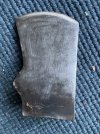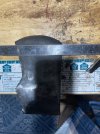PhilipWimberly
Gold Member
- Joined
- Oct 31, 2023
- Messages
- 78
Well, I dramatically overpaid for this, but have been itching for a 5 pounder, and...well...just got it. I've tried to get pictures that show how dramatic the difference is between the heel and toe, but these are the best I could do. It's worse than it looks. I've never "re-built" a bit this bad before...but I think I'm gonna try. Two questions:
1 - A LOT of YouTube instruction on this...and almost as much variance. Does anyone have a suggestion as to who does the best job teaching this? I reeeeally don't want to end up grinding it into a danged 4 pounder...
2 - Besides being ugly in this condition, what is the functional difference when it is this far off?
(Side note: This is one of the Collins with "Collinsville, CT" below the name Yesteryear does an incredible job of teaching the history of these tools -- so glad to have that resource -- but I've never seen a timeline of branding for axes. It seems like it would be possible to order all of the branding for an axe manufacturer by years the particular embossings were sold. I wonder if it is safe to assume that generally, Yesteryear has the oldest brands at the top and newer ones at the bottom?)
1 - A LOT of YouTube instruction on this...and almost as much variance. Does anyone have a suggestion as to who does the best job teaching this? I reeeeally don't want to end up grinding it into a danged 4 pounder...
2 - Besides being ugly in this condition, what is the functional difference when it is this far off?
(Side note: This is one of the Collins with "Collinsville, CT" below the name Yesteryear does an incredible job of teaching the history of these tools -- so glad to have that resource -- but I've never seen a timeline of branding for axes. It seems like it would be possible to order all of the branding for an axe manufacturer by years the particular embossings were sold. I wonder if it is safe to assume that generally, Yesteryear has the oldest brands at the top and newer ones at the bottom?)



